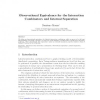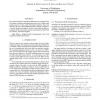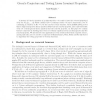103 search results - page 2 / 21 » A separation theorem in property testing |
ENTCS
2007
13 years 4 months ago
2007
We define an observational equivalence for Lafont’s interaction combinators, which we prove to be the least discriminating non-trivial congruence on total nets (nets admitting ...
ICASSP
2008
IEEE
13 years 11 months ago
2008
IEEE
The empirical mode decomposition (EMD) has seen widespread use for analysis of nonlinear and nonstationary time-series. Despite some practical success, it lacks a firm theoretica...
STOC
2009
ACM
13 years 11 months ago
2009
ACM
A system of linear equations in p unknowns Mx = b is said to have the removal property if every set S ⊆ {1, . . . , n} which contains o(np− ) solutions of Mx = b can be turned...
ENTCS
2008
13 years 4 months ago
2008
We present an extension to classical separation logic which allows reasoning about virtual memory. Our logic is formalised in the Isabelle/HOL theorem prover in a manner allowing ...
ISAAC
1992
Springer
13 years 9 months ago
1992
Springer
A (0,1)-matrix satisfies the consecutive ones property if there exists a column permutation such that the ones in each row of the resulting matrix are consecutive. Booth and Lueke...



